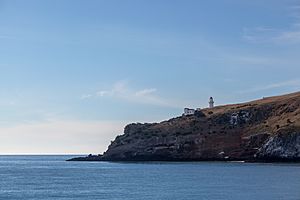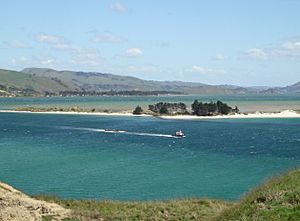Otago Heads facts for kids
The Otago Heads is an old name for the important coastal areas near the entrance of Otago Harbour in New Zealand's South Island. This harbour is actually a long, narrow bay that was formed from an ancient volcano.
The name "Otago Heads" usually refers to the settlements and headlands (points of land sticking out into the sea) on the Otago Peninsula. These include places like Taiaroa Head and Otakou, which are just inside the harbour's mouth. It also includes areas north of the harbour entrance, such as Aramoana, Long Beach, and the historic site of Whareakeake. Sometimes, the term also covers nearby Pacific coast areas of the Otago Peninsula, like Pipikaretu Beach.
These places were very important for early meetings between the first European settlers in Otago and the local Māori people. Otakou, for example, was a significant settlement before the city of Dunedin was founded in 1848. The Otago Heads area was also a vital Māori site long before Europeans arrived, and it holds many important archaeological discoveries.
Contents
Exploring the Otago Heads
What are the Otago Heads?
The Otago Heads are a collection of headlands and small towns located right at the mouth of the Otago Harbour. This harbour is a long, deep inlet of the sea, which was created from an ancient volcanic crater that filled with water over time. It's a key gateway to the city of Dunedin.
The term "Otago Heads" has been used for a long time. Today, it often refers specifically to Taiaroa Head and the Aramoana Mole. These two points form the narrow entrance to the harbour.
A Look at the Harbour Entrance
The entrance to Otago Harbour is quite narrow. At its tightest point, between the Aramoana mudflats and Harington Point, it's only about 400 metres wide. While the harbour is long, much of it is actually quite shallow, except for the main shipping channel called the Victoria Channel.
Because the harbour entrance is so narrow, and because many ships used to travel through it, especially during the Otago Gold Rush in the 1860s, there were many shipwrecks and other sea accidents near the Heads. To help guide ships safely, the entrance is guarded by two lighthouses: Taiaroa Head Lighthouse and Heyward Point Lighthouse.
History and Importance
The Otago Heads area has a rich history. It was a very important place for Māori people for centuries before Europeans arrived. Many archaeological sites here show evidence of early Māori life.
One of the most significant historical events at the Otago Heads was the signing of the Treaty of Waitangi in 1840. This treaty is New Zealand's founding document, and a signing ceremony took place here, making it a crucial location in the country's history.



